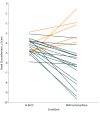Association of Severe Hydrocephalus With Congenital Zika Syndrome
- PMID: 30452526
- PMCID: PMC6439957
- DOI: 10.1001/jamaneurol.2018.3553
Association of Severe Hydrocephalus With Congenital Zika Syndrome
Abstract
Importance: Hydrocephalus is a treatable but potentially fatal complication that has not been previously described in congenital Zika syndrome (CZS).
Objective: To describe the clinical features and imaging findings in 24 patients with congenital Zika syndrome (CZS) who developed hydrocephalus.
Design, setting, and participants: This case series included patients with hydrocephalus who were born in October and November 2015 and followed up until mid-2017 in the 2 largest national referral centers for CZS in Brazil. The participants included consecutively enrolled children with a clinical and laboratorial diagnosis of CZS who developed clinical and/or image findings suggestive of hydrocephalus and who were confirmed to experience increased intracranial hypertension during ventriculoperitoneal shunt procedures.
Main outcomes and measures: To retrospectively describe clinical and image findings in these 24 patients.
Results: This multicenter cohort included 308 patients with CZS; 24 consecutive children were enrolled in this study. These children were aged between 3 to 18 months, and 13 of 24 (54%) were female. All patients presented with at least 1 positive test result for anti-Zika antibodies in cerebrospinal fluid or serum and had classic signs of CZS. At the time of hydrocephalus diagnosis, only 14 of 24 patients (58%) had symptoms and signs suggestive of hydrocephalus (mainly worsening seizures, vomiting, irritability, and/or sudden increase of head circumference percentile). Two of 24 patients (8%) had no symptoms suggestive of hydrocephalus but were found to have reduced brain volume on repeated imaging. Cerebellar or brainstem hypoplasia on baseline imaging were found in 18 of 23 patients (78%). At the second computed tomographic scan, all patients showed a marked increase of ventricular volume, compatible with communicating hydrocephalus, and reduction of brain tissue that was visibly worse than on baseline imaging for the 23 patients with repeated scans.
Conclusions and relevance: We present evidence that hydrocephalus is a complication of CZS in at least a proportion of patients. The clinical spectrum of this condition continues to evolve, but given that presenting signs and symptoms of hydrocephalus can be challenging to recognize in CZS, we provisionally recommend that high suspicion and appropriate monitoring for hydrocephalus should be part of the standard care of patients with CZS.
Conflict of interest statement
Figures



References
Publication types
MeSH terms
LinkOut - more resources
Full Text Sources
Medical

